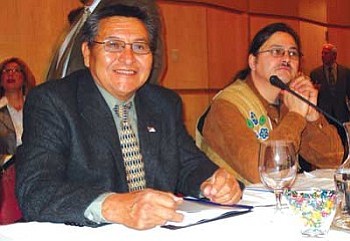Vice President Shelly, other tribal leaders meet with BIA Assistant Secretary Artman to discuss modernization
Navajo Nation Vice President Ben Shelly makes funding a priority
WASHINGTON, D.C.-The Vice President of the Navajo Nation was among a host of tribal leaders who gathered Feb. 6 at the Bureau of Indian Affairs (BIA) tribal initiative on modernization to discuss new approaches by tribes to speak on BIA efficiency, delivery of service and budget.
"The Navajo Nation is here at the table ready to participate in a tribally-driven modernization initiative," said Vice President Ben Shelly at Wednesday's meeting at the Ronald Reagan building on Pennsylvania Avenue. "It is inevitable that our proposals and ideas will differ with other Native nations."
Last Wednesday's modernization meeting was a follow up to Assistant Secretary for Indian Affairs Carl Artman's dialogue meetings with tribes to discuss how his office could prepare for staff requirements and ways to deal with rising operational costs and use of future technology.
In September, the Navajo Nation expressed a need for the BIA to continue with providing technical assistance for tribes to succeed in self-governance. Vice President Shelly stressed the need for funding for self-governance and functions that the Navajo Nation assumes from the federal government. In the gathering of concerns expressed by tribes last year, the BIA Web site that houses financial data and Trust Fund Office being placed back under BIA were among the top concerns.
"How do we face our internal challenges," asked Assistant Secretary Artman.
"With flat budgets how do we improve delivery of services? Is the BIA keeping up with tribal governments," were just some of the questions Assistant Secretary Artman posed.
"It's imperative to ask what is the commitment from this administration on implementation of our tribally-driven ideas," stated Vice President Shelly. "How do we address the main issue of funding?"
The decreasing amount of federal funds was the focal point of the meeting. Northwest regional tribes expressed that funding shortfalls make self-governance impossible.
"One of Navajo's internal discussions is to look at alternate ways of funding," said Vice President Shelly. "We would like to serve as one of the pilot areas you discussed earlier."
Discussion at the meeting included an ideal work group, with several task groups to work on specific issues that both tribes and the BIA can agree upon as priority.
An idea offered by Standing Rock Sioux Tribal Council Chairman Ron His Horse Is Thunder was to make law enforcement an agreeable priority to address public safety among tribes. Other tribal representatives expressed concern of law enforcement needs, but funding took a greater priority.
Both the tribes and the BIA expressed mutual agreement to make partnership a working action step in meetings to come. Service delivery at the local level and tribal input are themes to be taken up at the next Washington meeting.
The tribal leaders who gathered agreed to return to Washington March 6 to continue with setting up a work group that originally consisted of 12 representatives but expanded during the meeting to be inclusive of all tribes.
SUBMIT FEEDBACK
Click Below to:




